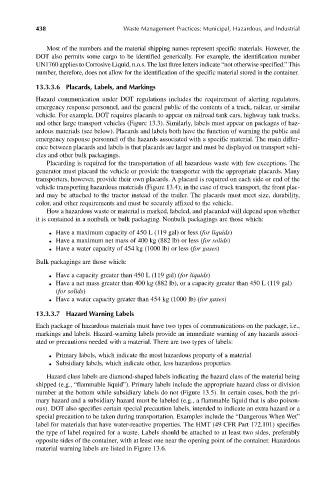Page 467 - Materials Chemistry, Second Edition
P. 467
CAT3525_C13.qxd 1/27/2005 12:30 PM Page 438
438 Waste Management Practices: Municipal, Hazardous, and Industrial
Most of the numbers and the material shipping names represent specific materials. However, the
DOT also permits some cargo to be identified generically. For example, the identification number
UN1760 applies to Corrosive Liquid, n.o.s. The last three letters indicate “not otherwise specified.” This
number, therefore, does not allow for the identification of the specific material stored in the container.
13.3.3.6 Placards, Labels, and Markings
Hazard communication under DOT regulations includes the requirement of alerting regulators,
emergency response personnel, and the general public of the contents of a truck, railcar, or similar
vehicle. For example, DOT requires placards to appear on railroad tank cars, highway tank trucks,
and other large transport vehicles (Figure 13.3). Similarly, labels must appear on packages of haz-
ardous materials (see below). Placards and labels both have the function of warning the public and
emergency response personnel of the hazards associated with a specific material. The main differ-
ence between placards and labels is that placards are larger and must be displayed on transport vehi-
cles and other bulk packagings.
Placarding is required for the transportation of all hazardous waste with few exceptions. The
generator must placard the vehicle or provide the transporter with the appropriate placards. Many
transporters, however, provide their own placards. A placard is required on each side or end of the
vehicle transporting hazardous materials (Figure 13.4); in the case of truck transport, the front plac-
ard may be attached to the tractor instead of the trailer. The placards must meet size, durability,
color, and other requirements and must be securely affixed to the vehicle.
How a hazardous waste or material is marked, labeled, and placarded will depend upon whether
it is contained in a nonbulk or bulk packaging. Nonbulk packagings are those which:
● Have a maximum capacity of 450 L (119 gal) or less (for liquids)
● Have a maximum net mass of 400 kg (882 lb) or less (for solids)
● Have a water capacity of 454 kg (1000 lb) or less (for gases)
Bulk packagings are those which:
● Have a capacity greater than 450 L (119 gal) (for liquids)
● Have a net mass greater than 400 kg (882 lb), or a capacity greater than 450 L (119 gal)
(for solids)
● Have a water capacity greater than 454 kg (1000 lb) (for gases)
13.3.3.7 Hazard Warning Labels
Each package of hazardous materials must have two types of communications on the package, i.e.,
markings and labels. Hazard-warning labels provide an immediate warning of any hazards associ-
ated or precautions needed with a material. There are two types of labels:
● Primary labels, which indicate the most hazardous property of a material
● Subsidiary labels, which indicate other, less hazardous properties
Hazard class labels are diamond-shaped labels indicating the hazard class of the material being
shipped (e.g., “flammable liquid”). Primary labels include the appropriate hazard class or division
number at the bottom while subsidiary labels do not (Figure 13.5). In certain cases, both the pri-
mary hazard and a subsidiary hazard must be labeled (e.g., a flammable liquid that is also poison-
ous). DOT also specifies certain special precaution labels, intended to indicate an extra hazard or a
special precaution to be taken during transportation. Examples include the “Dangerous When Wet”
label for materials that have water-reactive properties. The HMT (49 CFR Part 172.101) specifies
the type of label required for a waste. Labels should be attached to at least two sides, preferably
opposite sides of the container, with at least one near the opening point of the container. Hazardous
material warning labels are listed in Figure 13.6.

